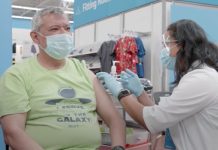DETROIT – Since the initial case of COVID-19 was diagnosed at the end of December 2019, there have been more than 2.3 million cases reported in the United States, causing more than 120,000 deaths as of June 23. Around the globe, there have been over 9.2 million cases reported, with nearly 477,000 deaths.
The outbreak of COVID-19 has significantly affected society as a whole and caused the cancellation of many events, conferences, classes and more around the world. With the continued increase in cases, there is an urgent need for a risk-prediction and update system so that individuals and various entities can be aware of the potential risk of infection when traveling locally, nationally or abroad.
Researchers from Wayne State University’s College of Engineering and the Henry Ford Health System are teaming up to design and implement such a system — and taking on several challenges in doing so. According to Weisong Shi, Ph.D., associate dean of research and graduate studies and professor of computer science at Wayne State, the team will work together to derive a system that can assess infection risk at different levels, such as individually or at large-event and institution levels. Shi also noted that the system must dynamically update the risk level based on the latest outbreak reports, as well as be able to preserve user sensitive data while sharing adequate and appropriate data that will allow risk-level calculation.
Shi and his team are attacking these challenges with the help of a $150,000 RAPID grant from the National Science Foundation (NSF), and a $10,000 Google Cloud Platform grant. The project, CORPUS: An Edge Intelligence-assisted Multi-Granularity COVID-19 Risk Prediction and Update System, will design and implement a system that includes a mobile app running on personal phones, as well as a large-scale distributed protocol behind the app that collects and updates the information.
“CORPUS will build a multigranularity risk-analysis model that will cover fine-grained personal risk; small, clustered meeting risk; and coarse-grained large clustered event/ organizational risk,” said Shi. “In addition, CORPUS will employ a data-propagation protocol to build and update the risk-analysis model.”
The data could include spatial data (such as a GPS signal), temporal data (such as calendar events), as well as input from the user (such as meeting with a specific person). To insure confidentiality of personal information, CORPUS will leverage privacy-preserving algorithms such as node-level feature pooling and anonymous parameters of the model instead of raw user data when multigranularity models request personal risk information.
“The great thing about CORPUS is that it will have the potential to meet the needs of many by leveraging personalized information and edge intelligence,” said Shi. “For a group or an organization, CORPUS will provide risk-related information to help them judge the feasibility of holding a meeting or an event during an outbreak, especially for large-scale international events, such as conferences and more.”
In addition, the system can proactively aid users in acting based on the risk information provided to reduce the spread of COVID-19. CORPUS will be able to assist governments to perceive the risk of infection in their jurisdictions, and thus guide infection prevention and control for effective governance.
The Google Cloud Platform will be leveraged to train the risk prediction and analysis models of CORPUS, as well as to host the cloud services for data storage.
In addition, the system can proactively aid users in acting based on the risk information provided to reduce the spread of COVID-19. CORPUS will be able to assist governments to perceive the risk of infection in their jurisdictions, and thus guide infection prevention and control for effective governance.
###
Shi’s collaborators include Ming Dong, Ph.D., professor of Computer Science at Wayne State University, and Marcus Zervos, M.D., infectious disease specialist at Henry Ford Health System and assistant dean of global affairs in the Wayne State School of Medicine.
The NSF Rapid Response Research (RAPID) funding mechanism allows the NSF to receive and review proposals having a severe urgency with regard to availability of or access to data, facilities or specialized equipment, as well as quick-response research on natural or anthropogenic disasters and similar unanticipated events, e.g., COVID-19.
The NSF award number for this project is 2027251.
Wayne State University is one of the nation’s pre-eminent public research institutions in an urban setting. Through its multidisciplinary approach to research and education, and its ongoing collaboration with government, industry and other institutions, the university seeks to enhance economic growth and improve the quality of life in the city of Detroit, the state of Michigan and throughout the world. For more information about research at Wayne State University, visit http://www.
TDnews














